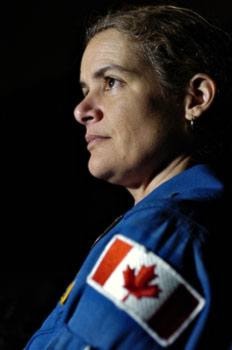On Friday, Canadian astronaut Julie Payette took Yukon elementary school students on a virtual trip to space.
She was at Whitehorse’s Vanier Catholic Secondary School to talk to students participating in this year’s Marsville project.
Marsville is a Canadian government initiative to get students in Grades 6 to 8 to understand what it would be like to live on and explore Mars.
In teams, they design and build life-support systems and communicate with other schools.
On Link-up Day, they come together to build a Mars habitat and showcase their survival systems.
As part of the Marsville project, students from Jack Hulland Elementary School, Whitehorse Elementary School and Mayo’s J.V. Clark School, built large plastic Mars habitats and held a homemade spacesuit fashion show.
Payette taught students what it is like to be one of the few Canadians who have travelled into space.
“Only 450 people have been into space and only eight of them were Canadian,” Payette told the students.
“By being a Marsville participant you are joining that brotherhood.”
Payette showed students photographs that illustrated what it is like to take off from Earth, land at the International Space Station and return to Earth in a spaceship.
Training is essential to astronauts, especially those colonizing Mars, she said.
“Training is what is going to make you a good Martian,” said Payette, who outlined how much training you go through in the space program.
Understanding how to live in weightlessness is one of the most important things, said Payette.
You are also taught to fly jets, which promotes lightning-fast decision making.
And you conduct Earth-bound explorations with her crew so that you could learn how to live in close quarters with other people.
She then explained the difference between a conventional rocket and a space shuttle.
A rocket is mostly made up of rocket fuel, which blasts a small capsule into space.
The space shuttle is attached to boosters, which break away after powering the craft into space.
The shuttle is the only reusable spacecraft.
Payette said she’s trained as a spacecraft operator and part of her job is knowing what all 1,800 buttons on the control board of the craft do.
“You have to know because there’s nobody on board to tell you what they do,” said Payette.
She explained the three phases of flight to the children.
The ascent – out of the Earth’s atmosphere.
The rendezvous – docking to the International Space Station.
The entry – coming back to Earth.
Although it only takes eight-and-a-half minutes to get into space, it takes 40 hours to travel to the International Space Station from Earth, said Payette.
The shuttle comes back to Earth at a speed of 2,800 kilometres per hour and touches down at 550 kilometres per hour.
Outside the spacecraft, during a space walk, the astronaut takes many safety precautions, said Payette.
First, the astronaut never lets go of the outside of the spacecraft, she said.
Second, the astronaut is tethered to the spacecraft and third, the astronaut is wearing miniature thrusters that can propel the astronaut back to the ship should she lose complete contact with it.
She even got into the fun stuff, explaining in detail just how the astronauts use the washroom and toilet on board the ship.
She had a picture, which showed a series of funnels and a seat to separate solid and liquid waste.
Payette didn’t over simplify her material because she was speaking to elementary school children.
“They get it and their minds are so active and creative — the questions they come up with are amazing,” said Payette in a later interview.
For example, she explained that liquid in a weightlessness environment, like the inside of a space shuttle, forms a globule and sticks to solid masses.
One child later asked what happens to your blood, which is liquid, in space.
The answer: nothing. Blood is contained by your body — it’s not floating free.
“It’s not the main part of our job, but it is the Canadian Space Agency’s mandate to educate children and encourage them to stay in school and get an education,” said Payette, who spends a couple of days every two months giving talks to school groups.
“It’s a very privileged aspect of the job, to be able to do this, and they look at us as if we know everything — which we don’t — or that we have the magical answer — which we don’t – the astronaut suit and the position is very highly regarded, so to me I also look at it as a responsibility,” said Payette after she spoke to the students.
“I hope they get something new out of it and that they feel empowered to pursue their own dreams — not everybody’s going to be an astronaut, thank the lord — however I hope everybody is going to be somebody in this room that I spoke to today and I hope that they are going to pursue their dream as far as they can take it.”
